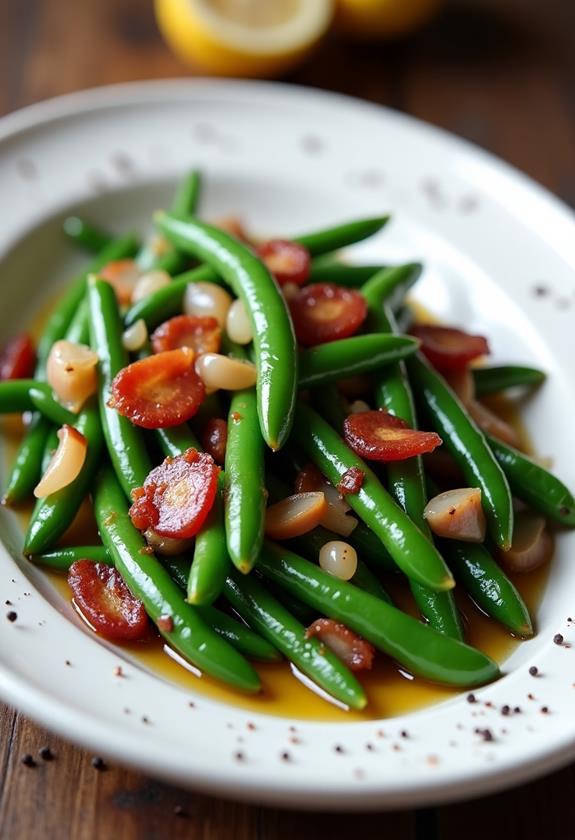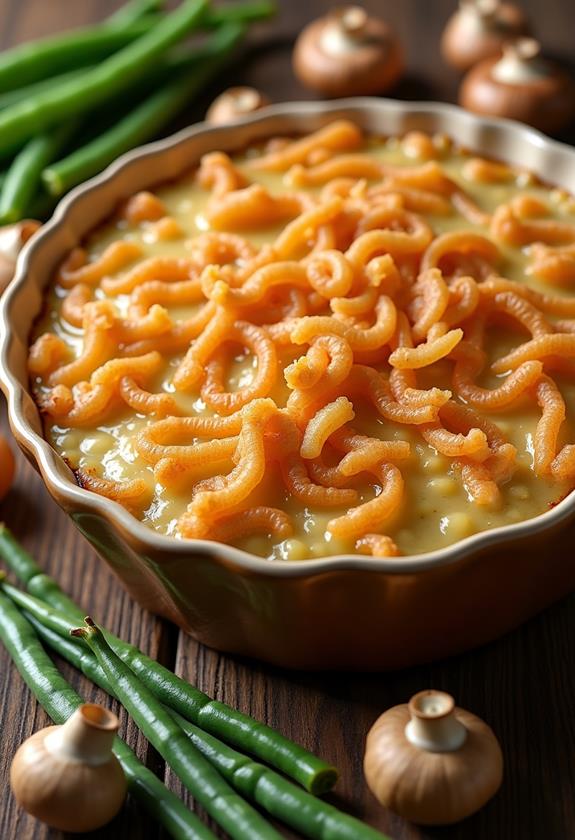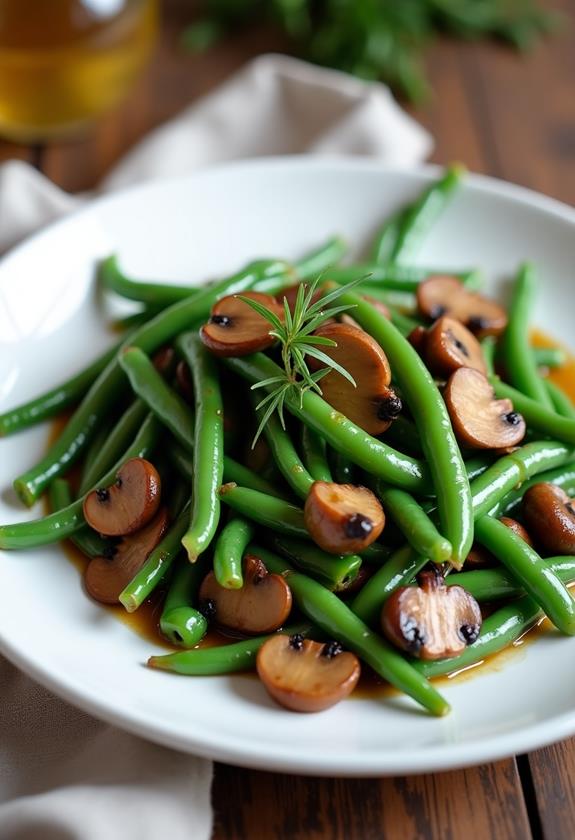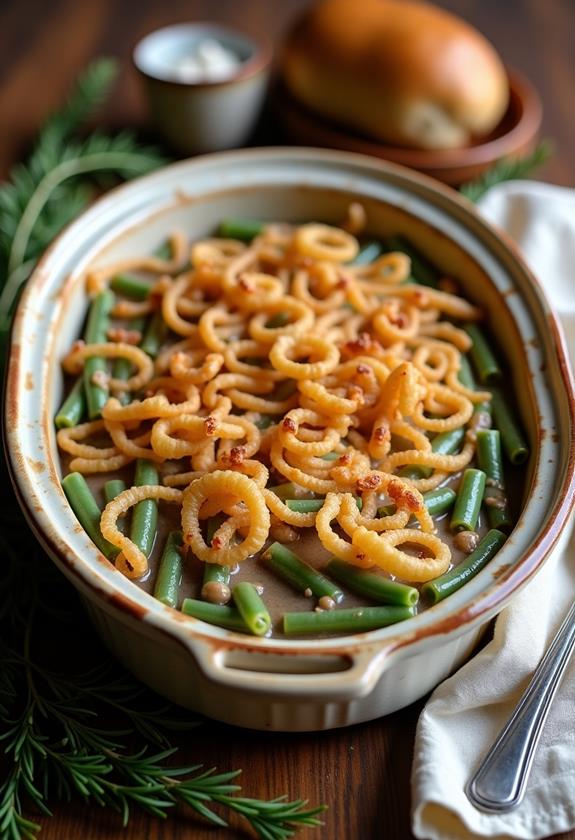Bacon And Green Beans Recipe

There’s something magical about the combination of crispy bacon and tender green beans that transforms a simple side dish into a showstopper. This Bacon and Green Beans recipe brings together the smoky, salty flavors of perfectly cooked bacon with the fresh, vibrant taste of green beans in a dish that’s both comforting and elegant.
Whether you’re preparing a weeknight dinner or hosting a special gathering, this recipe delivers restaurant-quality results with minimal effort. The secret lies in the perfect timing and technique that allows each ingredient to shine while creating a harmonious blend of flavors and textures.
What is Bacon and Green Beans?
Bacon and Green Beans is a classic American side dish that elevates humble green beans by cooking them with crispy bacon pieces and aromatics. This dish transforms ordinary green beans into a rich, flavorful accompaniment that pairs beautifully with roasted meats, grilled chicken, or holiday meals.
The cooking method involves blanching the green beans to maintain their vibrant color and crisp-tender texture, then sautéing them with rendered bacon fat and crispy bacon pieces. The result is a dish where the smoky bacon flavor permeates every bite while the green beans retain their fresh taste and satisfying crunch.
Ingredients List for Bacon and Green Beans
- 2 pounds fresh green beans, trimmed and cut into 2-inch pieces
- 6 strips thick-cut bacon, chopped into ½-inch pieces
- 1 medium yellow onion, thinly sliced
- 3 cloves garlic, minced
- 2 tablespoons butter
- ½ teaspoon salt (or to taste)
- ¼ teaspoon black pepper
- ¼ teaspoon red pepper flakes (optional)
- 2 tablespoons chicken broth or water
- 1 tablespoon fresh lemon juice
- 2 tablespoons fresh parsley, chopped for garnish
How to Cook Bacon and Green Beans: A Step-by-Step Guide
Creating the perfect Bacon and Green Beans requires attention to timing and technique. Here’s my detailed guide to ensure your dish turns out perfectly every time:
1. Prepare the Green Beans:
- Start by trimming the stem ends of the green beans and removing any strings.
- Cut the beans into uniform 2-inch pieces for even cooking.
- Bring a large pot of salted water to a rolling boil.
- Add the green beans and blanch for 3-4 minutes until bright green and crisp-tender.
- Immediately transfer to an ice bath to stop the cooking process and preserve the vibrant color.
2. Cook the Bacon:
- Place the chopped bacon in a large skillet or cast-iron pan over medium heat.
- Cook slowly, stirring occasionally, until the bacon is golden brown and crispy, about 6-8 minutes.
- The key is to render the fat slowly to achieve maximum crispiness without burning.
- Remove the bacon with a slotted spoon and set aside on paper towels, leaving the rendered fat in the pan.
3. Sauté the Aromatics:
- In the same pan with the bacon fat, add the sliced onions over medium heat.
- Cook for 4-5 minutes until the onions become soft and translucent.
- Add the minced garlic and cook for an additional 30 seconds until fragrant.
- Be careful not to burn the garlic as it can become bitter.
4. Combine and Finish:
- Add the blanched green beans to the pan with the onions and garlic.
- Toss everything together and cook for 2-3 minutes to heat through.
- Add the butter, salt, pepper, and red pepper flakes if using.
- Pour in the chicken broth or water to create a light glaze.
- Return the crispy bacon to the pan and toss gently to combine.
5. Final Touches:
- Remove from heat and add the fresh lemon juice for brightness.
- Taste and adjust seasoning as needed.
- Garnish with fresh chopped parsley before serving.
- Serve immediately while hot for the best texture and flavor.
Substitutions and Variations
This versatile Bacon and Green Beans recipe can be adapted to suit different dietary preferences and ingredient availability:
- Bacon: Turkey bacon or pancetta can be substituted for a different flavor profile, or omit entirely for a vegetarian version using olive oil instead.
- Green Beans: Fresh green beans work best, but you can use frozen green beans if fresh aren’t available (reduce blanching time).
- Onions: Shallots or leeks can replace yellow onions for a more delicate flavor.
- Herbs: Try fresh thyme, rosemary, or sage instead of parsley for different aromatic notes.
- Nuts: Add toasted almonds or pine nuts for extra crunch and richness.
- Cheese: A sprinkle of Parmesan cheese adds richness and depth to the dish.
Common Mistakes to Avoid
To ensure your Bacon and Green Beans turns out perfectly, avoid these common pitfalls:
- Overcooking the Green Beans: They should remain crisp-tender, not mushy. Watch the blanching time carefully.
- Cooking Bacon Too Fast: High heat will burn the bacon before the fat renders properly. Use medium heat for even cooking.
- Skipping the Ice Bath: This stops the cooking process and keeps the green beans bright green and crisp.
- Not Seasoning Properly: Taste and adjust seasonings throughout the cooking process.
- Adding Lemon Juice Too Early: Add it at the end to prevent the green beans from losing their vibrant color.
How to Serve Bacon and Green Beans
Bacon and Green Beans makes an excellent side dish for a variety of main courses. It pairs wonderfully with roasted turkey or chicken, grilled steaks, pork chops, or glazed ham. The dish is particularly popular during holiday meals, complementing traditional favorites like mashed potatoes and stuffing.
For a complete meal, I recommend serving this alongside roasted proteins and a starch like rice pilaf or roasted potatoes. The combination of flavors and textures creates a well-balanced plate that satisfies without overwhelming.
Presentation Ideas for Bacon and Green Beans
To make your Bacon and Green Beans visually appealing, consider these presentation tips:
- Color Contrast: Serve on white or light-colored plates to showcase the vibrant green color of the beans.
- Garnish Thoughtfully: Fresh parsley or microgreens add color and freshness to the final presentation.
- Serve in Style: Transfer to a beautiful serving platter rather than serving directly from the cooking pan.
- Temperature Matters: Serve immediately while hot for the best visual appeal and taste.
Bacon and Green Beans Recipe Tips
Here are my top tips for achieving the best results with this recipe:
- Choose Quality Ingredients: Fresh green beans and thick-cut bacon make a noticeable difference in the final dish.
- Prep Ahead: You can blanch the green beans and cook the bacon earlier in the day, then quickly assemble when ready to serve.
- Don’t Crowd the Pan: Use a large enough skillet to allow proper browning and even cooking.
- Save Some Bacon Fat: The rendered bacon fat is liquid gold for flavor – use it wisely in the cooking process.
- Timing is Everything: Have all ingredients prepped before you start cooking, as the final assembly happens quickly.
How to Store Bacon and Green Beans
Allow the Bacon and Green Beans to cool completely before storing (within 2 hours of cooking). Transfer to an airtight container and refrigerate for up to 3-4 days. The dish can be reheated gently in a skillet over medium-low heat or in the microwave, though the green beans may lose some of their crisp texture upon reheating.
For best results, I recommend reheating in a skillet with a splash of water or chicken broth to prevent sticking and restore moisture. Avoid overcooking during reheating to maintain the best possible texture.
Frequently Asked Questions (FAQs)
Q: Can I use frozen green beans instead of fresh?
A: Yes, but reduce the blanching time since frozen green beans are already partially cooked. Thaw them first and blanch for only 1-2 minutes.
Q: Can I make this dish ahead of time?
A: You can prep components ahead, but it’s best assembled and finished just before serving to maintain the best texture and flavor.
Q: What’s the best type of bacon to use?
A: Thick-cut bacon works best as it provides substantial pieces and renders more fat for cooking the vegetables.
Q: Can I make this dish vegetarian?
A: Absolutely! Omit the bacon and use olive oil or butter for cooking. Add smoked paprika for a smoky flavor.
Q: How do I know when the green beans are properly cooked?
A: They should be bright green and crisp-tender – you should be able to pierce them easily with a fork but they should still have a slight crunch.
Q: Can I add other vegetables to this dish?
A: Yes! Mushrooms, bell peppers, or cherry tomatoes make excellent additions. Add them when you sauté the onions.
Conclusion
This Bacon and Green Beans recipe represents the perfect marriage of simplicity and flavor. By following these detailed instructions and tips, you’ll create a side dish that’s both elegant enough for special occasions and simple enough for everyday meals. The combination of crispy bacon, tender green beans, and aromatic vegetables creates a dish that never fails to impress.
I’ve found that this recipe is incredibly forgiving and adaptable, making it a reliable go-to for both novice and experienced cooks. The key is in the technique – proper blanching, careful bacon cooking, and thoughtful seasoning – which transforms basic ingredients into something truly special.
Remember that great cooking is about more than just following a recipe; it’s about understanding your ingredients and adjusting as needed. Taste as you go, trust your instincts, and don’t be afraid to make the recipe your own. With practice, this Bacon and Green Beans recipe will become a cherished part of your cooking repertoire, bringing comfort and satisfaction to every meal. Happy cooking!



